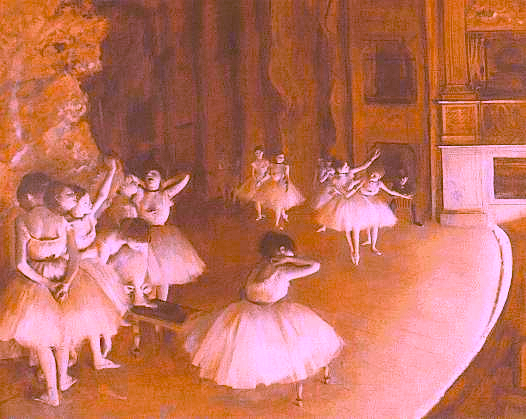
The blogger’s life is all about constantly creating new content to foist upon an eager world, but I have to say, I was so pleased with the way yesterday’s post turned out that I was tempted, albeit briefly, just to pretend that I couldn’t get to my computer for the next week or so. That way, the post would have lingered at the top of the blog for a nice, long time, all of you would have had some time to ponder your individual authorial voices, and I would have gotten a bit of a vacation.
Wait, why did I decide not to do this? It sounds like a great idea.
Oh, yeah: we’re rapidly heading toward August, and I didn’t want to slow down anyone’s revision efforts. Specifically, I did not want any of you coming to me in mid-September, saying, “Wow, Anne, I wish I’d known some of the editing fixes you were talking about late in the summer before I sent off my submission to the agent of my dreams! But there we were, just a few short weeks before the annual August exodus, and you decided to take a week off. Unbeknownst to anyone concerned, the piece of advice that would have enabled me to turn my opus from pretty good to yowsa would be in the very next post!”
Oh, you may laugh — but would you care to hear just how often readers or students in my classes have said similar things to me?
A small forest of hands shot into the air in the middle of the quote from the fantasy creature I choose to regard as representative of future readers. Yes, hand-raisers? “But Anne, why would mid-to-late July be a particularly poor time for you to stop lecturing us on craft issues? And what did your imaginary friends mean about the annual August exodus?”
Ah, the answers to those two trenchant questions are interconnected, my friends. Traditionally, enough of the NYC-based publishing world goes on vacation between the end of the second week of August and Labor Day that it’s genuinely difficult to pull together an editorial committee in order to approve the acquisition of a manuscript or book proposal. That means, in practice, that agents are not all that likely to be able to sell books during this period, so they, too tend to go on vacation during that period. Oh, a Millicent or two might be left behind to watch the store while the rest of the agency seeks less humid climes, but generally speaking, it’s a dead zone.
What does that mean for aspiring writers, you ask? Why, that mid-August through mid-September isn’t usually the best time to query or submit. Unless, of course, one happens to harbor an active desire to have one’s query or manuscript sit on a desk for a month or two.
Did that vast collective gasp mean that at least some of you were expecting to hear back sooner — or at any rate, for Millicent and her boss to get cracking immediately after midnight on Labor Day? Think about it: if you didn’t go into work for a few weeks, how much mail would pile up on your desk?
Got that image firmly in mind? Good. Now imagine the state of that desk if you routinely received 800-1200 queries per week.
On a not entirely unrelated note, had I mentioned that the next few weeks would be a great time to get those queries out the door? Or to polish up and send off those requested materials?
To facilitate your pursuing one or both of those laudable goals, I’m going to be winding down the Frankenstein manuscript series with today’s post. Oh, we’re not going to be leaving the wonderful world of craft — beginning with my next post, we’re going to take a serious foray into pepping up your dialogue. But for the nonce, we’re going to be stepping away from manuscript-polishing issues, so that you may more easily take the time to…well, polish your manuscript.
And honestly, weren’t you getting just a little tired of all those Roman numerals?
To round out the series with a bang, I’m going to devote today to challenging you to assess yet another reader’s actual text. Rather than present you with her opening pages, however, I’m going to show you an action scene, of a sort, and encourage you to try to spot potential revision opportunities.
Why launch into a mid-book scene, you ask, rather than my usual target of choice, the opening pages? Partially, so we could talk about pacing — as the expressive industry term sagging in the middle may already have led you to suspect, narratives are more likely to slow there than at either the beginning or the end — but also, as is my wont, to answer a reader’s question. Quoth abbreviation devotee Kathy:
What if your world, so to speak, involves a skill that not everyone is familiar with? In my case, my MC is a dance student, and much of the WIP occurs during her classes at a studio.
I’ve gotten comments from critters saying both put in more details about the step or combinations and leave out the details. So how do I balance out the necessary details so non-dance readers can visualize my MC’s dance movements and not put in so many that it stalls the action?
As delighted as I am at the mental image of critters providing feedback on a manuscript (and as concerned as I am that not every reader will know that MC = protagonist and WIP = work in progress; while WIP is arguably writing-class jargon, MC is not), this question has been causing me some chagrin. As we have seen throughout this series, this is precisely the kind of question that is impossible to answer without taking a close look at the scene in question — as much as aspiring writers might like for there to be hard-and-fast formulae for figuring out this kind of proportion, what works honestly does vary from story to story.
Yet now that we have a nice, well-stocked revision tool kit, we need fear no writing fix-it challenge. So let’s take a peek at Kathy’s pages with an eye to improving them, shall we?
Before we do, though, I have a confession to make: when I use readers’ examples here, I have been known to clean up the formatting prior to posting them. That way, the reader kind enough to allow me to write about actual text gets the benefit of specific feedback, and you, dear readers, don’t become confused by seeing improperly formatted pages.
Since this is going to be the last concrete example in this series, however, I’m going to show at least the first page of this one initially as it arrived in my e-mail. Kathy’s made two extremely common mistakes for a submitter; Millicents whose boss agents accept e-mail queries and submissions see these all the time. I’m rather pleased to be able to show them to you in their natural habitat, as most professional readers will automatically reject requested materials with either.
See if you can catch them on her first page. Hint: either would be apparent to Millicent the agency screener from ten feet away.
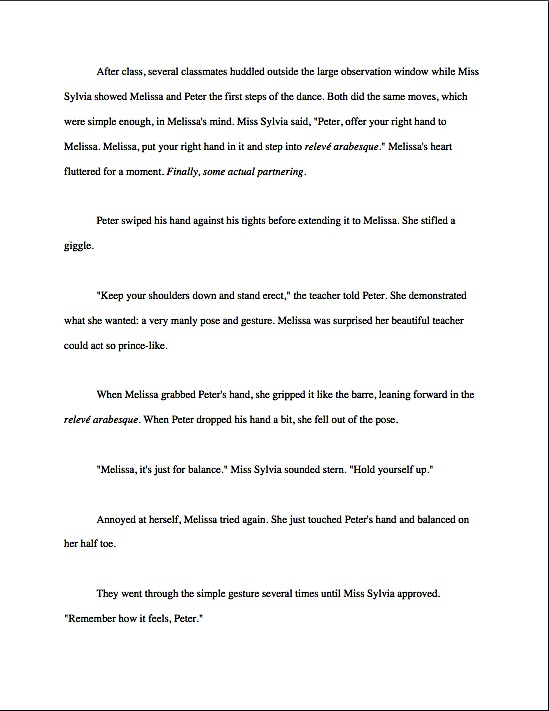
See the problem? This page is not formatted like a manuscript page: it lacks a slug line (and thus any way to identify this page, should it become separated from the rest of the submission), and there is a skipped line between each paragraph. Also, although it may be hard to tell in this version, the writer skipped only one space after each period and colon, rather than two, rendering it significantly harder to edit. (Which, admittedly, some agents would prefer; check their websites for specific instructions on the subject.)
It’s formatted, in short, as though it were intended for insertion into the body of an e-mail, not as samples from a manuscript page. Which would have been appropriate only had the professional reader in question (in this case, me) specifically asked for the materials to be sent — wait for it — in the body of an e-mail.
In case anyone’s wondering, that request is usually reserved for electronic queries where the agency likes to see a few pages of text or a bio. It’s virtually never the expectation when an agent or editor asks a successful querier or pitcher to send actual manuscript pages.
That’s why, in case you’d been wondering, I’m particularly pleased to be able to show you this phenomenon in action as I wrap up the Frankenstein manuscript: this level of formatting gaffe might easily be sufficient to prevent Millicent from reading any of the text at all, at least if her agency asked (as I did) for the pages to be sent as a Word attachment, the industry standard means of online submission.
In case I’m being too subtle here: formatting counts in submissions, even e-mailed ones.
That’s not, alas, as widely-known an axiom as it should be. Like so many aspiring writers, Kathy probably mistakenly believed that what this professional reader wanted to see was the content of the requested pages, but that’s not the only thing being judged in a submission. Any professional reader would also be looking to see if the submitter was aware of how manuscripts should be put together.
Why is it problematic if a submission consists of just writing, rather than writing presented in standard manuscript format? Even if Millicent read it and fell in love with the writing, the presentation just screams that this would be a time-consuming client to take on: clearly, she would need to be shown the ropes.
And that, from the other side of the submission desk, is a problem — or, depending upon how serious Millicent is about ever seeing her desktop again, a solution. Given that a good agent will routinely receive 800-1200 queries per week (yes, even during the August break), and that she gets enough properly-formatted submissions to fill her few new client spots hundreds of times over, why should she instruct her Millicent to read improperly formatted materials? By the same token, why should Mehitabel the contest judge consider those same materials for finalist status in a literary contest?
That last bit was not entirely rhetorical, by the way. In the Great First Pages contest I sponsored here in May, a good third of the entries were not properly formatted. Rather surprising, as the rules asked that entries be submitted in standard format as a Word attachment. Or it might have surprised me, had I not so often served as a contest judge; experience had taught me how often contest entrants simply do not read the rules with care. (But don’t worry, Great First Page entrants: finalists have been selected, and the winners shall be announced soon.)
The moral, should you care to hear it: unless an agency, small publishing house, or writing contest’s rules either ask you to submit your writing in the body of an e-mail or SPECIFICALLY ask for some other kind of presentation, you should assume that they’re expecting to see standard manuscript format. And if you don’t know what that should look like on the page, run, don’t walk, to the posts in the aptly-named HOW TO FORMAT A MANUSCRIPT category on the archive list at right.
Heck, for starters, you could just look at today’s example again, now that I’ve taken the time to format it as Millicent would expect to see it. (As usual, if you are having trouble reading the example, try holding down the COMMAND key simultaneously with +, to enlarge the image.) To protect the innocent, I’ve taken the liberty of changing the last name of the submitter, as well as the title of the book.
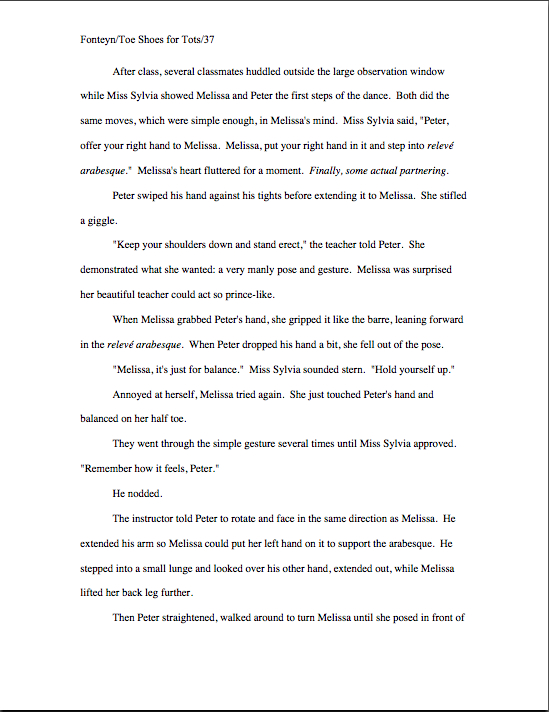
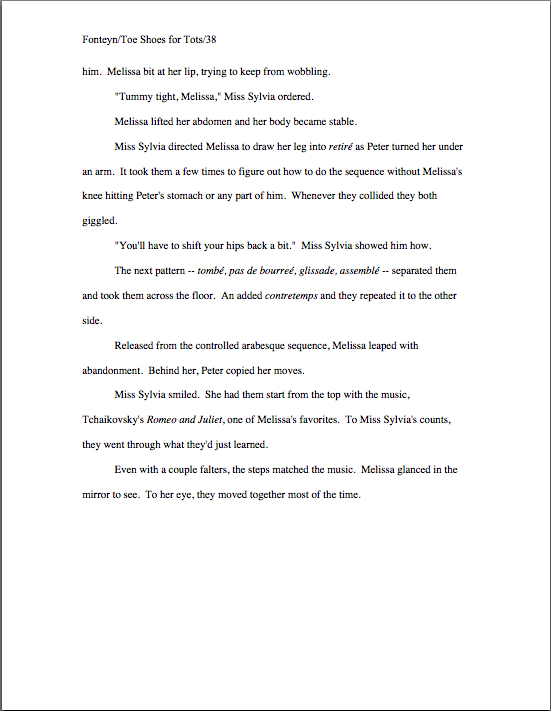
Ready to tackle Kathy’s question now? Well, probably not, if you’ve been following this series closely. I’m guessing that what jumped out at your first was all the word repetition, right?
In case it didn’t, let’s apply our usual test for word and phrase frequency, to see how this page would have looked to Millicent’s critical eye. Notice in particular the name repetition.
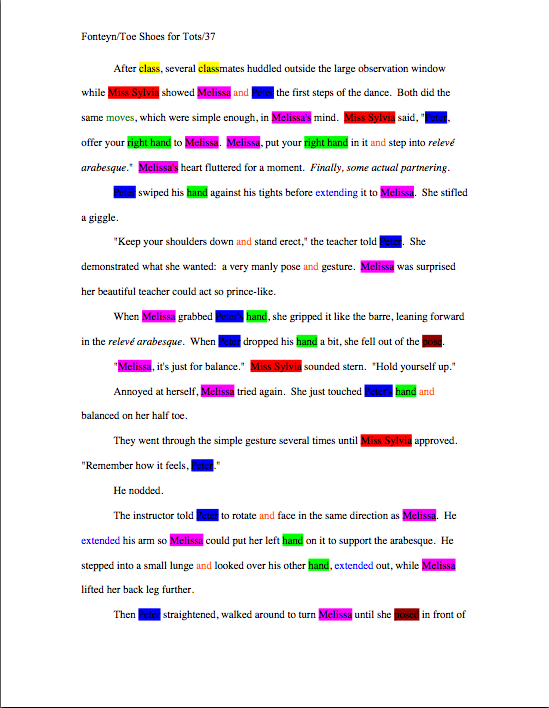
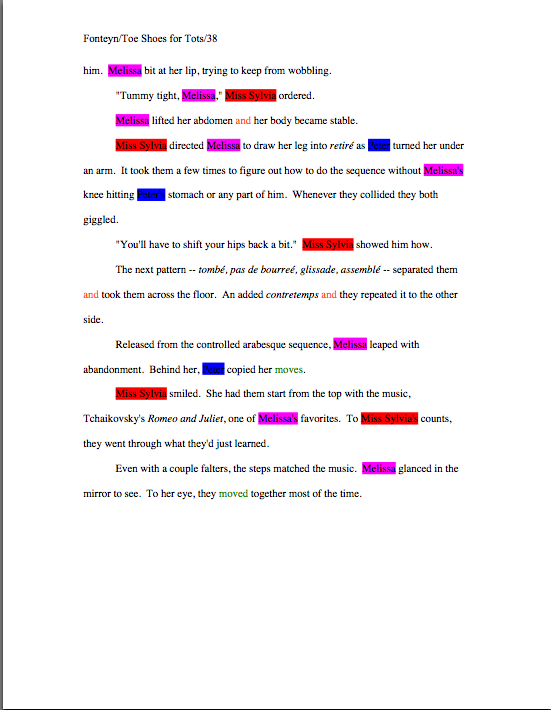
Colorful, isn’t it? Since we have already discussed word choice stagnation in general and name repetition in particular in some detail in this series, I don’t want to dwell too much on these problems as they manifest here. Except to point out one thing: notice how hard it is to evaluate the text on any other basis while all of that repetition is starting you in the face?
It’s every bit as hard for professional readers. So should anyone still be looking for a great first step toward an overall revision, I would highly recommend starting with word and phrase repetition.
But where, if a savvy reviser had to choose, would the next level of revision start? Would it, as Kathy suggests, be at the jargon level, reassessing the amount of actual dance steps in this scene?
That’s a legitimate concern, but I tend to doubt that would be the very next problem Millicent would notice. Assuming that word repetition is off the table, here are the kinds of issues that might concern her.
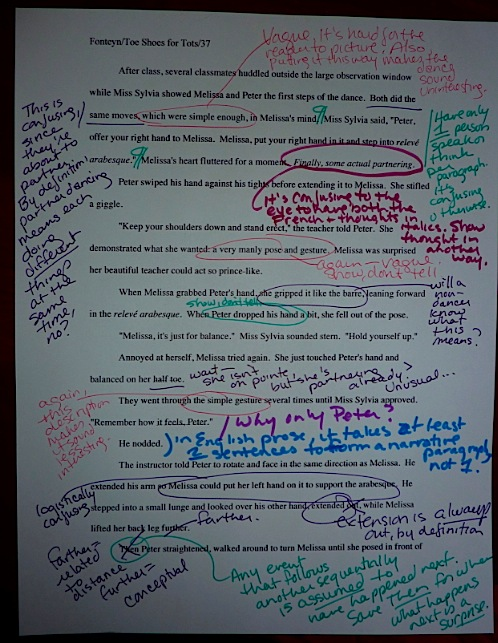
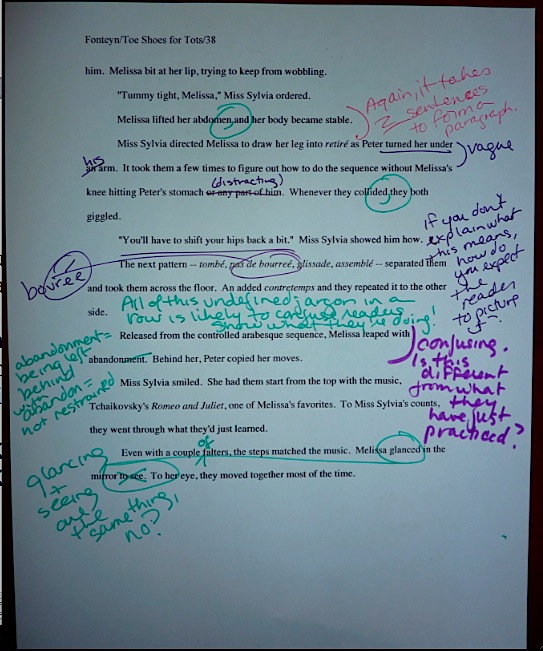
Again, where to begin? My vote would be in the first paragraph, with a problem that dogs many a manuscript these days, especially in YA: having more than one character speak or think per paragraph.
Actually, paragraph #1 presents a couple of rather interesting thought dilemmas. Take a gander as it currently stands:
After class, several classmates huddled outside the large observation window while Miss Sylvia showed Melissa and Peter the first steps of the dance. Both did the same moves, which were simple enough, in Melissa’s mind. Miss Sylvia said, “Peter, offer your right hand to Melissa. Melissa, put your right hand in it and step into relevé arabesque.” Melissa’s heart fluttered for a moment. Finally, some actual partnering.
The perspective is a trifle puzzling here, even for an omniscient narrative. In the first sentence, the action is seen by third parties, from the other side of a window. In the next sentence, the narrative jumps into Melissa’s head, but in sentences #3 and #4, Miss Sylvia is speaking. Yet in sentences #5 and #6, we’re back in Melissa’s perspective, underscored by #6′s italicized thought.
A touch confusing to the spatial sense, is it not? No worries — a bit of judicious application of the pinkie to the RETURN key will instantly clarify matters:
After class, several classmates huddled outside the large observation window while Miss Sylvia showed Melissa and Peter the first steps of the dance. Both did the same moves, which were simple enough, in Melissa’s mind.
“Peter, offer your right hand to Melissa,” Miss Sylvia said. “Melissa, put your right hand in it and step into relevé arabesque.”
Melissa’s heart fluttered for a moment. Finally, some actual partnering.
See how the simple act of giving each perspective its own paragraph removes any possibility of perspective drift? Not to mention being allowing a far more conventional presentation of dialogue.
Do I see some raised hands out there? “But Anne,” italicized thought-lovers everywhere exclaim as one, “why did you remove the italics around Melissa’s thought? They were used correctly the first time around, weren’t they?”
Well, yes, they were — although that’s a qualified yes, since there are plenty of Millicents out there for whom italicized thought equals lazy writing. (Their rationale: “Shouldn’t a genuinely talented writer be able to alert the reader to the fact that the protagonist is thinking without resorting to fancy typefaces?”) Amongst those who do accept this convention, though, Kathy’s use here would definitely fly.
So why did I chose to eschew italics here? Simple: there are so many French terms in this scene. On the manuscript page, it’s rather confusing to the eye to have both the foreign terms and the thought italicized; as the French had to be italicized, the thought was the obvious one to change.
And I ask you: wasn’t it still clear that the last sentence was Melissa’s thought?
Of course, for an editorial change like this to work, it would have to be made consistently throughout the entire manuscript — altering it in this scene alone, or even only in the jargon-heavy ballet scenes, might well result in text that read like a mistake. Every fiction writer needs to decide for herself whether to italicize thought or not, and then cling to that resolve like a leech. (But if you would like some guidance on how to italicize thought correctly, you might want to check out the ITALICS AND WHEN THEY ARE CORRECT TO USE category on the archive list at right.)
There’s another structural problem, also related to RETURN key usage, that might also strike your garden-variety Millicent’s eye forcefully. Any guesses?
If you instantly sent your fingertips shooting skyward, shouting, “By gum, there are a couple of single-sentence paragraphs in this excerpt, but it takes at least two sentences to construct a narrative paragraph,” you have either been paying close attention throughout this revision series, or your eyes are sharp enough to have picked up the rather dim red marginalia above. While a dialogue paragraph can indeed be a single sentence long:
“But I like single-sentence paragraphs,” Kathy pointed out.
it’s technically incorrect to limit a narrative paragraph to a single sentence, like so:
He nodded.
As we’ve discussed, the prevalence of single-sentence paragraphs in newspaper and magazine writing (in AP style, they are perfectly acceptable) has led to an ever-growing acceptance of the things in published books, particularly nonfiction. That’s not going to help you, however, if your Millicent should happen to have graduated from a college with a particularly good English department.
If you just like the way single-line paragraphs look — many an aspiring writer seems to positively pine for them — use them as judiciously as you would profanity. To co-opt Mark Twain’s quip about taking the Lord’s name in vain, select a time when it will have effect. How about, for instance, limiting their use to when the statement that follows a full paragraph is actually surprising?
Again, we’ve already talked about this issue earlier in the series, so I shall not harp upon it. For the moment, it’s enough to realize that Millicent would notice and zero in such paragraphs — enough so that it really would behoove the writer to make sure that he’s deriving some significant benefit from breaking the rules. In this excerpt, at least, neither of the single-line paragraphs rises to that level of usefulness.
I hear a positive fusillade of fingertips drumming on desks. “But Anne,” cut-to-the-chase types protest, “while all of this is interesting, from a self-editing perspective, you haven’t yet addressed Kathy’s question. Is there a reason that we needed to discuss all of these technical matters before getting to the issue of whether she’s overusing detail here?”
Yes, actually, a very good reason: from a professional reader’s perspective, it’s difficult to assess questions of style before the more basic writing issues — spelling, grammar, clarity — and presentation requirements — our old pal, standard format; choices like word repetition and italic use that might produce eye distraction on the page — have been resolved. That’s partially why I’ve been talking about attacking a Frankenstein manuscript in waves of revision: as each level of text scrubbing takes place, the style and voice lying just beneath can emerge.
It follows, then, as dawn succeeds the night, that as a self-editing writer winnows away his manuscript’s technical problems, underlying stylistic difficulties may leap to the fore. In the case of today’s example, two related problems have cropped up — maintaining narrative tension and the use of necessary technical jargon.
Let’s tackle the latter first. Kathy had asked how best to tell how much detail to include in her dance studio scenes, but from the perspective of a reader unfamiliar with ballet terminology, there’s actually not a great deal of detail in this scene. There is, however, quite a bit of dance jargon, a series of phrases that leap off the page by virtue of being italicized.
Why, we were discussing the eye-distraction potential of those words and phrases just a few moments ago, were we not? What a coincidence.
The fact that so many of these terms are in French, and thus require italicization, is not the only reason that the ballet jargon is problematic in this excerpt, however. Much of the time, the jargon is taking the place of description, not adding to it.
What’s the difference, those of you who have done some time in ballet class ask? The answer to that one is easy: please tell us, readers who don’t know an arabesque from the proverbial hole in the ground, how are you picturing the action in this scene?
Not very clearly, I’m guessing — which is almost always the case when a narrative leans very heavily upon jargon for its descriptions. Naming an action or object is not the same thing as showing what it looks like, after all.
That’s genuinely a pity in this scene, as I suspect (having put in my time in ballet class) that the movements the characters are making would be quite pretty to see. So my first choice for stylistic revision would be to replace at least some of the jargon with some lyrical description of flowing arms and tremulous balances, enough so that a reader who did not know much about dancing could still enjoy the movement of the scene.
And you thought I wasn’t going to answer Kathy’s question!
The other problem — maintaining narrative tension — also speaks to her concern. If the level of detail is too high, the tension of the scene can suffer; as we discussed last time, one way to keep an action scene moving along is the thoughtful application of summary statements.
So I ask you: is the level of detail appropriate for the ideal pacing of the scene?
I’m turning it over to you in part because personally, I find that question a trifle difficult to answer; I suspect a reader who had not spent her wayward youth glissading and pas de bouréeing would have quite a different response than one who had. If the target audience is made up solely of girls who live in leotards, the level of detail may not need to be tweaked much. If, however, the intended readership includes — and I think it should — kids who always wanted to take dance classes but have not had the opportunity, the illustrative details should be ramped up a thousandfold.
You want them to feel as though they are in that dance studio, don’t you?
Not convinced that’s a pacing issue? You bet your boots it is. A reader already familiar with the terminology would be able to skim through this scene in 60 seconds flat. She might long for more connection to the plot and characters as they exist outside of the dance studio — all three characters in this scene seem to be living entirely in the moment, a relatively rare condition for both real-world residents and characters in books — but I doubt she would feel that the scene dragged. Its characters have a goal to achieve, and they attain it in under two pages.
But what of our other reader, the one who will either be puzzled by the undefined jargon or will simply skip over it? (Not an uncommon response to encountering technical talk on the page, by the way.) To her, the scene might well seem slow, or even confusing. What are these people doing, she wonders, that cannot be described adequately in English?
Hey, I wasn’t kidding about revision solutions seldom being one-size-fits-all; a savvy self-editor is constantly juggling any number of relevant issues. Because this is a not a simple process we’re talking about, my friends — like an onion, a Frankenstein manuscript with potential has many, many layers.
And can induce tears.
Keep those good craft questions rolling in, everybody, and many thanks to Kathy for letting us take an informative peek at her manuscript. Next time, we tackle dialogue — but may I suggest taking a glance at the calendar and perhaps resolving to send out a query or two on the side?
Keep up the good work!
First, I would like to thank Kathy for offering up her pages for the slaughter. It takes a lot of guts to let the rest of the world see your book in it’s proverbial underwear. Bravo!
Second, I would like to thank Anne for being so gracious as to show us the revision steps of an unedited manuscript. I learned more from watching you systematically edit Kathy’s pages in this short example than I have in some entire editing classes. *cough* Perhaps we could see such Reality TV editing examples in the future.
To add some feedback on the pages from a reader’s POV (one who hasn’t had any dance lessons whatsoever), I DID have a hard time picturing the scene in general because there was just jargon. As a writer of fantasy, I sympathize with your pain Kathy. I am constantly juggling details of the world, trying to figure out what is need to know information and what is merely my own fanatical love for my made up setting. 😉
When there are details necessary for understanding the story, I try to place them into a scene with a good bit of tension already built in. So for your scene, I might put some technical details alongside Melissa worrying about whether she’s going to get the moves correct. She might try extra hard to remember the basics, giving you a realistic way to describe the moves she would already know, and filling the scene with the additional tension of Melissa’s concerns.
Good luck with revisions!
I like the idea of giving Melissa a counter-emotion, Elizabeth P!
Thanks for talking about August in NYC today, Anne. I used to work out of New York a lot. I’ve been so hell bent to complete my proposal that I completely forgot how it’s a ghost town in August. Will it work if I get a batch in the mail by Monday the 26th or should I wait until September? Would I have any better luck sending it to agents outside of NYC during this time? Also, you mentioned to get query letters mailed and I was curious about that — why is it a good time to send a query if not a proposal? I’m still researching agents, but it seems that with nonfiction, most prefer at least a portion of the proposal with the query.
Again, thanks in advance for any and all advice on this Anne. Honestly, what would we do without you?
You’re usually okay if you can get it out by the end of the first week of August, Marsha. There’s often a flurry of activity just before everyone decamps, but even if you miss that, you’re usually better off being in the Received Before Vacation pile. So unless you think another month or so of polishing would improve your proposal substantially, I’d go ahead and send out that flurry now.
And yes, you would have better luck with agencies outside NYC during the fallow period. I’m not sure I understand your question about queries vs. proposals, though — I was advising against sending anything out after the first week of August and before Labor Day.
Thanks, Anne, you have set the course for my weekend. I will flurry away! And, yes, I did misunderstand your queries vs. proposals statement — perhaps because of the phenom you’ve so often written about of scanning on the computer screen even when we think we’re reading every word! I’ll make a point to slow down a bit when perusing your much appreciated blogs. Have a great weekend, Anne. I have officially buried myself in the trenches until pages are printed, folders are stuffed and personal queries accompany them into envelopes!
Excellent, Marsha! Onward and upward!
Thanks, Kathy, for sharing the pages. 🙂
Having had a little bit of dance training, I didn’t have much trouble knowing what you were talking about, but I felt hungry for more. Simply saying what they were doing without giving me any concrete images (her posture opening in the arabesque, the teacher’s chest and chin rising as she assumed the princely pose) felt too superficial. It’s hard to know when you have enough detail; my problem is usually too much. I think it’s not about adding MORE; it’s about choosing which descriptive highlights are the most important to convey the image.
As far as August is concerned, I’m going to send out some more queries RIGHT NOW. I just made a longer list of agents. No more single queries; a bunch are going out next Monday. At least they’ll be there, and maybe I’ll beat someone to the punch. It takes so long to get a reply that I’ll have plenty of time to finish this revision. 🙂
Good for you, Elizabeth W!
Thanks for sharing your work with us, Kathy. Anne, I also found it very helpful to have a scene disected that way.
I agree with Elizabeth about the specific moves. I never had the oportunity to take dance, and even with my daughter in dance now, I don’t know the jargon.
I’m sure what you imagined was a splendid peice, but not knowing what twists and turns they took, or if they their hearts were racing from the exertion left the scene a little flat to me.
With that said, I think if you only put in those moves in layman’s terms that are the most difficult to pull off, it might be helpful. It sounded interesting, and it must have been to have the hallway so crouded with other students watching.
I just wish that I would have been able to see it too. The hardest thing for us to know, I think, is how the scene that is so clear in our mind will be viewed by a reader. Best of luck revising!
Thanks again, Anne, for a great post!
I’m glad to hear that you found it helpful, Christie. Since three of you have said the same thing, though, I’m curious: was this post MORE helpful than the others where I have talked about readers’ work? If so, was it because it was an entire scene?
I think that Adam is correct. This post combined all of the information you have been sharing with an easy to understand format. I liked all of the colored highlighters, and to see your comments on each issue, helped me to see areas that I need to check as well.
I think that I am a visual person, and having what was written represented this way was a great help to me. I think that the length was helpful as well because it was a complete scene.
I also agree with Adam.
It was helpful to see the “practical applications” of the intense manuscript edit you’ve been talking about. It’s easy to get lost in the little details, so seeing you systematically tackle one scene using all of the other bits that we learned was enlightening. It made the Frankenstein edit seem less scary because I could instantly see in one scene how a professional editor would cut all of the chaff and get to the heart of the scene.
I especially liked the different colors, and your written-in comments. I also think this post was so helpful because it was a reader’s work, and not something you made up for the example. Don’t get me wrong—I love your examples. But you also have superior editing and writing skills, so your rough draft is liable to look much nicer than some of your reader’s rough drafts (*kaffkaff*like mine).
Wow, that’s fascinating to hear, Elizabeth P — I’d actually had some reservations about posting full-on editing feedback for an actual reader. (Which explains why it took me almost five years of blogging to do it.) I’d just assumed that it would intimidate people into quivering jelly. How nice that I was wrong about that.
I completely agree about my examples, by the way. I think there’s value in my writing them when there’s a specific issue at stake, so I can highlight it, but for a general overview, it’s really interesting (for me as well) to see what readers are writing.
Thanks, Christie — this is all so helpful for me to hear. I’m the queen of colored pens, so it all seems very natural to me.
I’ll add my kudos too – thanks Kathy! I think what I found really helpful about this post was the treatment you gave it, Anne. You’ve spent 23-odd individual posts about Frankenstein manuscripts, and while each has very concrete examples to illustrate your points, this is the first time (I think) you’ve gone through what amounts to several consecutive edits on the same text using what we’ve learned. It really is like an onion! I don’t know if it helped me that the example you used was an entire scene or was only long enough to have issues we are likely to encounter in our own work. The length gives enough for us to look at development, which is more difficult to do if we’re only looking at the first page of a chapter, or a few paragraphs. The experience was at the same time overwhelming and entirely approachable. There may be a lot of editing each of our own works may need, but it can – and should – be approached in a as methodical a manner as possible so as to not fry our own circuits needlessly.
You’ve spent 23-odd individual posts about Frankenstein manuscripts, and while each has very concrete examples to illustrate your points, this is the first time (I think) you’ve gone through what amounts to several consecutive edits on the same text using what we’ve learned.
Oh, that’s really helpful to know, Adam. I can certainly do that again. I’ve even been toying with running readers’ pages and going over them as a regular feature. I think it’s more useful to see real examples, rather than ones I make up.
Thanks Anne. I cannot tell you how helpful your blog is. Wait, I just did. I’ve even given you some press in a newsletter I write for savvyauthors.com about your character naming suggestions, but this post is really one of your very best. The example is dead on. Now, back to my revising!!!
What a lovely set of compliments, Leslie! Thank you so much — and thank you for the press!
Hey Anne, I’m still in a flurry to get as many proposals out as possible by mid-week and have a quick question for you. In tailoring the query and proposal to the agent, is it acceptable to alter the category as well? In nonfiction there appears to be a great deal of overlap and there are times when my specific category isn’t listed on the agent’s website, but another, similar one is. Thanks again!
Yes, Marsha. It’s not only acceptable; it’s smart. And it’s not as though the Millicent at one agency will be comparing queries with the Millicent at another.
Good! That’s what I thought. Can’t always trust gut instincts so I thought I’d check with the pro. Must run – more printing to do! Thanks and have a great day!